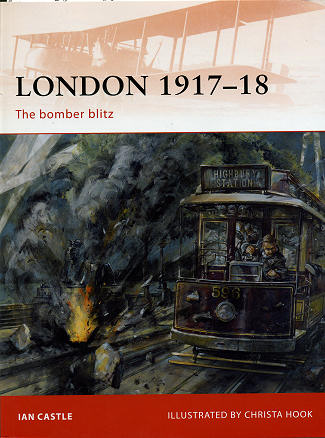 During
WWI, it was a goal of the German air services to bomb the British capital of
London in the thought that such a rain of destruction would cause the population
to lose the will to continue the war.
During
WWI, it was a goal of the German air services to bomb the British capital of
London in the thought that such a rain of destruction would cause the population
to lose the will to continue the war. Osprey's London 1917-18: the bomber blitz
|
Author: |
Ian Castle, illustrated by Christa Hook |
|
Publisher/Distributor |
Osprey Publishing |
|
Price |
$19.95 MSRP |
|
Reviewer: |
|
| Notes: |
96 pages, 7¼ x 9¼ inches, softcover ISBN:978-1-84603-682-8 |
 During
WWI, it was a goal of the German air services to bomb the British capital of
London in the thought that such a rain of destruction would cause the population
to lose the will to continue the war.
During
WWI, it was a goal of the German air services to bomb the British capital of
London in the thought that such a rain of destruction would cause the population
to lose the will to continue the war.
First, the Germans tried to use zeppelins as the major bomb carrying craft. This worked with some initial success, but these vessels proved to be too slow, costly to build, and were frequently shot down, even when they switched to night tactics. After a couple of years of trying, the Germans gave up on the idea and then switched over to aircraft.
The major bomber of the Germans at the time was the Gotha and in May of 1917, a flight of 23 of these planes took off to attack London. Several turned back due to troubles and the remaining aircraft were dogged by poor weather on the way, so bombed targets closer to the coast. All without any harassment from the British. A second flight a few days later was much more successful as the British were not at all prepared for these raids, having few guns and even fewer aircraft to intercept them. As such, daylight raids became the norm and quite successful in not only the damage caused, but also in the panic it caused the population. Londoners who stoically went through the zeppelin bombings were now panicked by these new attacks.
Of course, the British soon developed defenses after much finger pointing in higher echelons and the Germans had to switch to night bombing. This was even more troublesome as they had to have clear, moonlit nights to enable them to navigate. The Gothas were joined by the huge Stakken bombers in the various raids, though in actuality, the number of planes that actually were able to participate was never large. Eventually the British figured out a way to make the raids costly for the Germans and a year after they started, the raids stopped for good.
Ian Castle takes us through these raids with precise information on not only the aircraft involved, but also the flight path of each one and where each bomb was dropped. It is this level of detail that made the earler book on the Zeppelin raids so fascinating. It is also what makes this book such a superb read. As with all the Campaign books we are introduced to the major players in the campaign as well as their plans.
Thanks to the superb collection of period photos and the illustrations of Christa Hook, we are able to better see what the results were of these bomb raids, and they are every bit as destructive as those caused during WWII, just not on as large a scale.
It makes for a fascinating look at what is probably the first long range bombing campaign. It is a book that I know you will enjoy and can easily recommend for you.
November 2010
For more on the complete line of Osprey books, visit www.ospreypublishing.com. In the US, it is Osprey Direct at 44-02 23rd St, Suite 219, Long Island City, NY 11101., where you can get a catalogue of available books.
If you would like your product reviewed fairly and quickly, please contact me or see other details in the Note to Contributors.